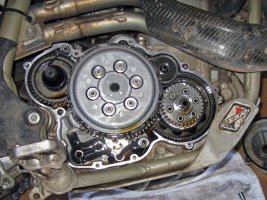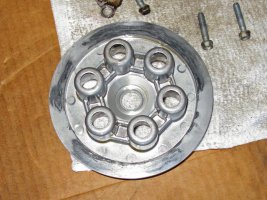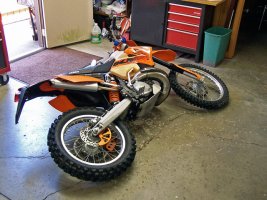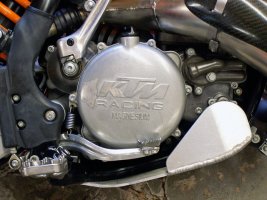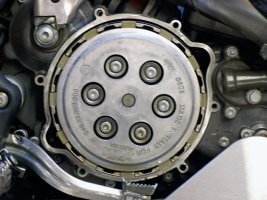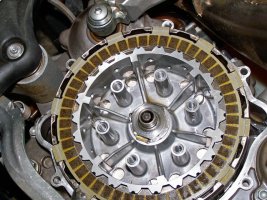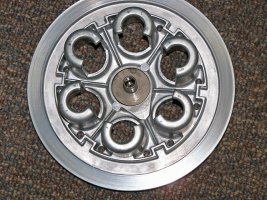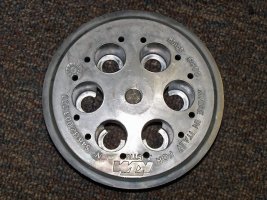A couple of years ago I purchased a new 06 KTM 300 XC-W to replace my aging 02 CRF-450R ... it has been an excellent bike in every respect ... rides well, is comfortable, plenty of power and will chug through almost anything you can throw at it. However, soon after I put a few hours on the meter, the clutch began making a terrible "squawking" noise on engagement after the bike had reached normal operating temperatures. I have searched a multitude of dirt bike sites looking for reasons and/or solutions to this "squawking" problem ... all to no avail.
Interestingly, a buddy of mine recently obtained a virtually new 04 KTM 525 MXC from his brother who rode the bike twice and then let it set in the garage for several years. After cleaning up the bike, changing the oil, new plug, new fuel and new tires he began riding the bike in the mountains of Colorado and Moab. Aside from having MXC gearing, the bike rode nicely ... except, when fully warmed up, the clutch would also make a terrible "squawking" noise. Since my buddy was riding it in the mountains, fanning the clutch mandatory at times because of the tall MXC lower gears ... both the poor "engagement feeling" and the constant "squawking" of the clutch were driving him crazy. Although he was aware my clutch also made these noises, it took the problem coming to roost in his barnyard to get him working on it in earnest. Being a trained mechanical engineer and long time dirt biker, he was eminently qualified for the endeavor.
Recently he called to tell me that he had run across a post on KTM Talk that suggested the "squawking" noise was caused by insufficient oil getting into the plate stack at operating temperatures and at dynamic rpms. Seems that some KTM clutch pressure caps and inner basket designs do not allow sufficient oil to enter the central cavity of the clutch unit when it is spinning ... which at least appears to make sense with regard to the fact that both my 300 and my buddy's 525 clutches operate noiselessly after setting overnight and only begin to "squawk" after warming up ... oil easily seeps into the plate stack when the clutch is static for an extended period of time.
It is fair to state that my buddy tried several other "cures" before investigating the one I am about to describe ... e.g.; changing oils, disassembling the clutch and cleaning the plates, checking the plates for size and shape imperfections ... none of them provided a permanent cure. Note that disassembly of the clutch and cleaning the plates does help for a short period, but the squawking returns after only a few tens of engagements.
Fundamentally, the "cure" for "squawking" amounts to boring several extra holes in the pressure cap assembly thereby allowing more oil to enter the central cavity of the clutch while it is spinning so centrifugal force can push it out through the plate stack which thereby keeps the plates from sticking together and moving as a group rather than sliding over each other independently. It is this "group movement" within the stack that causes the poor engagement feel and the "squawking" noise.
The following are several pictures showing how he accomplished said task on his 04 KTM 525 MXC.
Interestingly, a buddy of mine recently obtained a virtually new 04 KTM 525 MXC from his brother who rode the bike twice and then let it set in the garage for several years. After cleaning up the bike, changing the oil, new plug, new fuel and new tires he began riding the bike in the mountains of Colorado and Moab. Aside from having MXC gearing, the bike rode nicely ... except, when fully warmed up, the clutch would also make a terrible "squawking" noise. Since my buddy was riding it in the mountains, fanning the clutch mandatory at times because of the tall MXC lower gears ... both the poor "engagement feeling" and the constant "squawking" of the clutch were driving him crazy. Although he was aware my clutch also made these noises, it took the problem coming to roost in his barnyard to get him working on it in earnest. Being a trained mechanical engineer and long time dirt biker, he was eminently qualified for the endeavor.
Recently he called to tell me that he had run across a post on KTM Talk that suggested the "squawking" noise was caused by insufficient oil getting into the plate stack at operating temperatures and at dynamic rpms. Seems that some KTM clutch pressure caps and inner basket designs do not allow sufficient oil to enter the central cavity of the clutch unit when it is spinning ... which at least appears to make sense with regard to the fact that both my 300 and my buddy's 525 clutches operate noiselessly after setting overnight and only begin to "squawk" after warming up ... oil easily seeps into the plate stack when the clutch is static for an extended period of time.
It is fair to state that my buddy tried several other "cures" before investigating the one I am about to describe ... e.g.; changing oils, disassembling the clutch and cleaning the plates, checking the plates for size and shape imperfections ... none of them provided a permanent cure. Note that disassembly of the clutch and cleaning the plates does help for a short period, but the squawking returns after only a few tens of engagements.
Fundamentally, the "cure" for "squawking" amounts to boring several extra holes in the pressure cap assembly thereby allowing more oil to enter the central cavity of the clutch while it is spinning so centrifugal force can push it out through the plate stack which thereby keeps the plates from sticking together and moving as a group rather than sliding over each other independently. It is this "group movement" within the stack that causes the poor engagement feel and the "squawking" noise.
The following are several pictures showing how he accomplished said task on his 04 KTM 525 MXC.
Attachments
Last edited:
